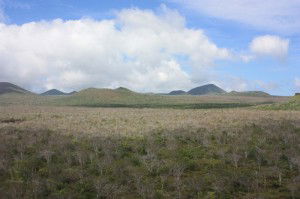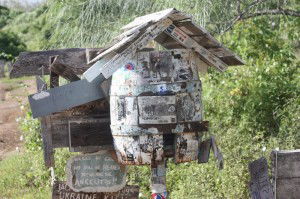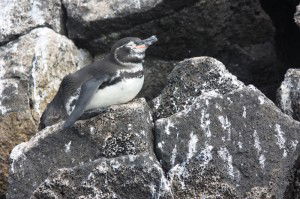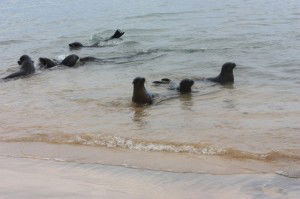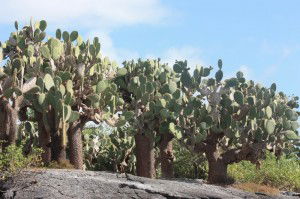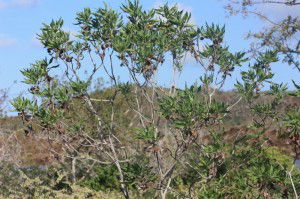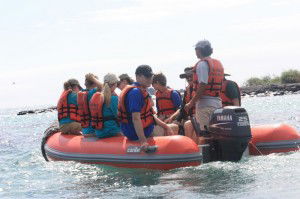Galapagos Adventure—Day 6
Today we visited the island of Floreana. It is also one of the oldest islands and has some 50 peaks, each of which represents an inactive volcano. It’s hard to imagine this beautiful lush landscape once consisting of tons of molten lava.
Floreana is famous for having the first post office in the Galapagos Islands. A large wooden barrel serves as a post office that was first set up by whalers to get messages back home. No internet or phones in the 1700s! They would simply put a letter in the barrel with a name and location of where it needed to go. Then another whaler would come along and look at the letters and if he lived in close proximity to where it needed to go would take it with him back home. Apparently it worked very well and the tradition continues today with people putting postcards in to be picked up by others and mailed home. I picked up one that I will send to Harrisburg, Pennsylvania.
The former use of the island by whalers, buccaneers, pirates, and the presence of human inhabitants has come at a cost. Several foreign plant and insect species have been introduced to the island (as well as other islands). Some of the native and endemic (meaning found only in the Galapagos and no other place in the world) species have disappeared. There is an insect species that lays its eggs on a certain type of tree that is found on this island which kills it. Blackberry is also a problem. Apparently the seeds can live for up to 12 years in the ground making it almost impossible to eradicate. A bird called the smooth-billed ani was introduced by people who owned cattle in the hopes of controlling cattle ticks but instead it eats many of the island insects and threatens the ecology. Tortoises also used to inhabit Floreana but were taken for food by whalers and pirates to the extent that they completely disappeared from the island. Darwin collected a species of mockingbird from Floreana that since his time has disappeared.
We were informed by our naturalist that the Charles Darwin Research Station is doing research into how to recover and preserve the plants and animals of the islands. In one case they have introduced a beetle to eat the insect that lays its eggs on the plant as described above. Of course introducing one species to kill another introduced species could have negative effects as well but so far this beetle has not been disruptive to the ecology of the islands. The research station also hopes to re-introduce the giant tortoise and mockingbird through their successful captive breeding programs.
I was so excited to see a Galapagos penguin today! There was only one but our naturalist assures us we will see more later. They are the only penguin to live north of the equator and can do so because of the cold water upwelling that occurs in the Galapagos, which is rich in food. We also saw several flamingos for the first time in a brackish inland lake. They were far off in the distance, but again, we are to see more later. They feed on a shrimp in the lake that was thought to give them the pink color. But it was later discovered that they also eat a fungus that is tinted pink, and that is responsible for their pink coloration. The sand of the portion of the lake that is drying up (it is dry season) has a pinkish tinge to it from the fungus.
Again we saw blue-footed boobies, marine iguanas (not as red on this island), and lava lizards (they seem to be everywhere). There is one species of lava lizard that exists on all of the central and western islands, but six of the eastern islands have their own unique species that is specific to that island.
My favorite part of the day was visiting a sea lion “nursery.” This is a protected cove that sharks and other predators are unable to access due to the rocks and shallow water. There were many sea lion babies that were very intrigued by our boats. They swam beside us, jumped in and out of the water like a dolphin, and overall seemed to think we were great entertainment! Several of them even followed us to our next landing point and must have been disappointed when we left the water to hike on land. That was truly an experience I will never forget.
We also saw a brown pelican flying and fishing and Galapagos green turtles swimming and saw their nests on the beach. I got some great pictures of the tree-like prickly pear and a representative of the Scalesia family. Scalesia is the sunflower family and here it grows as a woody bush or tree-like plant versus the herbaceous version that is familiar to most of us. It was not in bloom but you can see from the picture just how different it looks! The tree-like prickly pear and Scalesia are unique to the island habitat and it’s amazing to think of the diversity of genetic information that God put in each of these plants to achieve such different forms under different conditions.
It has been very difficult to call home due to our remote location. Only one person is getting a decent cell phone signal so everyone is using his phone. It’s been good to make contact with Elizabeth and know she is doing fine. I hope to be able to call Chris tomorrow. Thank you for all your prayers for my family.
Tomorrow we visit Santa Fe and the twin Plaza Islands. Enjoy the pix!

Answers in Genesis is an apologetics ministry, dedicated to helping Christians defend their faith and proclaim the good news of Jesus Christ.
- Customer Service 800.778.3390
- © 2024 Answers in Genesis


